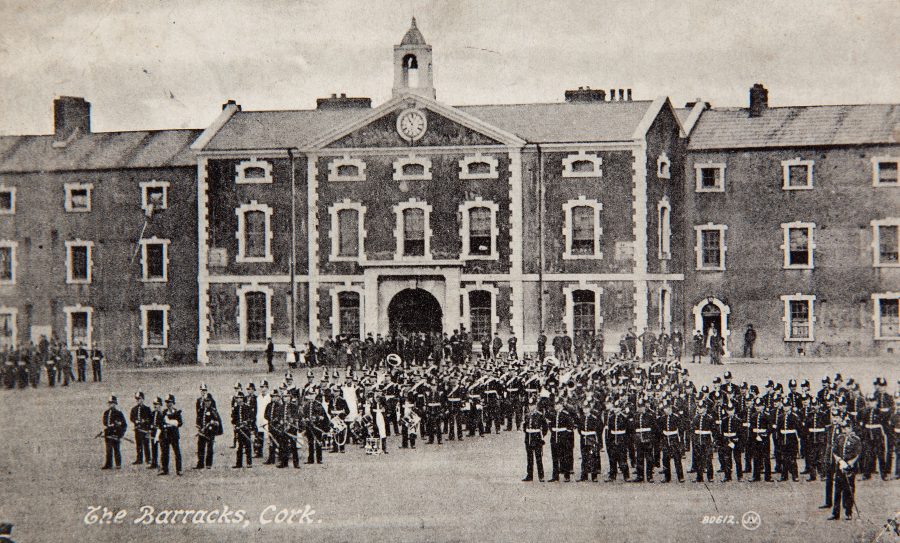
Kieran’s Our City, Our Town Article,
Cork Independent, 17 June 2021
Journeys to a Truce: The Cage of The Barracks
Crown forces patrolled city centre streets en mass in June 1921. Orders were issued that all prisoners should be chained to the lorries so that they could not attempt an escape. In addition, if the lorry was ambushed by the IRA, the prisoner could be caught in the crossfire. Prisoners were also used when the lorries were being sent out on some essential business to discourage any ambushers.
Prisoners were mainly detained in Victoria Barracks. Seán Healy, Captain of A Company, 1st Battalion, Cork IRA Brigade No.1, in his witness statement for the Bureau of Military History (WS1479) describes that he was detained in a cell for three days before he was taken before the official photographer. He was compelled to pose for a photograph in different positions, and this was followed by the taking of his fingerprints. He was then removed to a place called The Cage in the heart of Victoria Barracks.
The Cage was erected on the barrack square and consisted of three large military huts surrounded by several rows of 12 feet high barbed wire entanglements with armed sentries patrolling around it day and night. Prisoners in The Cage were supposed to have taken part in the city shootings, and a notice was hung on the outside requesting identification. There were about 150 prisoners in The Cage – roughly fifty in each hut. There was an outer circle of barbed wire, which was covered with canvas. Between the two lines of wire the sentries patrolled. The outer wire had a number of spy holes, which enabled those outside to see in.
Seán describes that this camp was erected, as an emergency measure and was more or less a clearing station. During the three weeks that he was detained there he witnessed about 1000 prisoners passed through its gates. Most of the men were arrested on suspicion and their records were subsequently investigated. If evidence could be produced that any of them took part in actions against the crown forces, they were then court-martialled and sentenced by the Military Courts. In most cases they were sent to internment camps without any trial. Spike Island was the destination of large numbers who passed through.
As the stay was usually of short duration, no beds were provided but blankets, which had to be frequently deloused. Seán remarks; “We slept on low trestles on, which were placed three or four boards. The number of boards depended on the number of prisoners that had to be catered for. Large numbers of curfew breakers, tramps, down-and-outs and adventurers were brought in nightly, during curfew hours, and simply bundled into the huts…I was attached to No.1 dormitory”.
Newcomers were all screened next morning in the hope of finding some wanted IRA man, and the rest were released. The usual procedure was for a sergeant to enter The Cage, call out the names of some wanted men who were removed there and then, no information being given of the business for which they were required or of their destinations.
Amongst those brought in at night was an occasional spy, but the Cork IRA members usually had not much trouble in spotting them, and after hassling them this hastened their moving out again for their own safely. Military matters were never discussed with strangers and IRA prisoners generally were very guarded in their conversations as the smallest leakage would lead to trouble. The spies were specially planted for the purpose of seeking information regarding ambushes, etc.
Seán details that on the whole, life in these huts was not the worse situation it could be; “The food, which was supplied was fairly good, and we were allowed to receive parcels from outside friends. I must place on record the kindness of my former landlady, Miss Mary Farrell of Lower Road, with whom I was staying at the time of my arrest. This lady walked up the steep. hill to the barracks with food and cigarettes almost daily. She was one of those fine types of Irishwomen who bravely faced the perils of the time. No visitors were allowed near the camp and all letters were strictly censored”.
Reveille was sounded at 7am and lights out were at 10pm. Activities brightened camp life considerably. Seán describes that there were sing-songs and dances, and Micheál Ó Gráda held Irish classes. Mass was said in one of the huts every Sunday morning by the Military Chaplain. Seán recalls: “Solitaries were brought up from their cells to attend Mass. Commandant Mick Murphy was amongst those unfortunate men. I saw him being marched up the centre of the Mass hut with a soldier on each side of him and nobody was allowed to go near him. No newspapers were allowed into the camp, but the fresh prisoners who arrived almost daily, to replace those who had been sent to Spike Island, Ballykinlar, etc., kept us supplied with up-to-date war news”.
Seán’s trial was not proceeded with afterwards as the Truce came into being on 11 July 1921. Others were not as lucky. Seán describes the case of Mick Leahy; “I remember Mick Leahy being released about 1pm on a certain Friday, and the very next night the murder gang called at the hotel where he was staying (Wren’s Hotel, Winthrop Street) They asked to see Mr Michael Leahy and when he appeared they immediately opened fire on him with revolvers. Thinking that he was shot dead, they took their departure. This man was very badly wounded but regained his health after a long illness”.
Caption:
1104a. Victoria Barracks, now Collins Barracks, Cork, c.1910 from Cork City Reflections (Amberley Publishing, 2021) by Kieran McCarthy and Dan Breen.